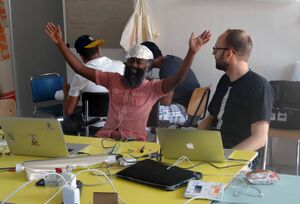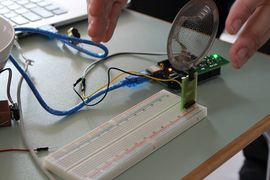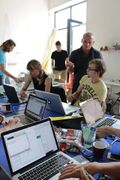DIY theremin making: Difference between revisions
(Made page) |
No edit summary |
||
| (23 intermediate revisions by 6 users not shown) | |||
| Line 1: | Line 1: | ||
{{Event | |||
|Name=DIY theremin making | |||
|Location=De Punt, Frans de Wollantstraat 84, 1018 SC Amsterdam | |||
|Date=2015/08/06 | |||
|Time=10:00-18:00 | |||
|PeopleOrganisations=Andrey Smirnov | |||
|Type=HDSA2015 | |||
|Web=Yes | |||
|Print=Yes | |||
}} | |||
[[File:11816093_786710411446676_957404096743146435_o.jpg|Theremin|thumb|]] | |||
===Exploring the application of theremin-based systems in various fields=== | |||
[[Andrey Smirnov|Andrey's]] workshop offered an hands-on introduction to interactive systems, based on the theremin-sensors - small and sensitive digital theremins similar to the well known electronic musical instrument, invented by Russian inventor Leon Theremin in 1919. They are useful for numerous applications, including motion tracking, gestural interfacing, monitoring of small variations of electrical capacitances related to any sorts of conductive materials and media, including metal objects, foil, water, human body, plants, metal threads, thin plastic films with metallization etc. | |||
From the start of the workshop participants converted their laptops into digital theremins, using as an interface Arduino microcontroller or just an ordinary sound card. The sensors for testing and experimenting as well as all appropriate software libraries was be provided by the Andrey. The theoretical introduction, which accompany a workshop, gave technical overview of sensor technology and construction, basic principles of operation of the theremin based systems, art and music applications, useful concepts and ideas. | |||
<gallery mode=packed> | |||
File:Theremin-board.jpg | |||
File:Andreyexplains.jpg | |||
</gallery> | |||
Latest revision as of 13:04, 13 December 2017
| DIY theremin making | |
|---|---|
| Name | DIY theremin making |
| Location | De Punt, Frans de Wollantstraat 84, 1018 SC Amsterdam |
| Date | 2015/08/06 |
| Time | 10:00-18:00 |
| PeopleOrganisations | Andrey Smirnov |
| Type | HDSA2015 |
| Web | Yes |
| Yes | |
Exploring the application of theremin-based systems in various fields
Andrey's workshop offered an hands-on introduction to interactive systems, based on the theremin-sensors - small and sensitive digital theremins similar to the well known electronic musical instrument, invented by Russian inventor Leon Theremin in 1919. They are useful for numerous applications, including motion tracking, gestural interfacing, monitoring of small variations of electrical capacitances related to any sorts of conductive materials and media, including metal objects, foil, water, human body, plants, metal threads, thin plastic films with metallization etc. From the start of the workshop participants converted their laptops into digital theremins, using as an interface Arduino microcontroller or just an ordinary sound card. The sensors for testing and experimenting as well as all appropriate software libraries was be provided by the Andrey. The theoretical introduction, which accompany a workshop, gave technical overview of sensor technology and construction, basic principles of operation of the theremin based systems, art and music applications, useful concepts and ideas.


